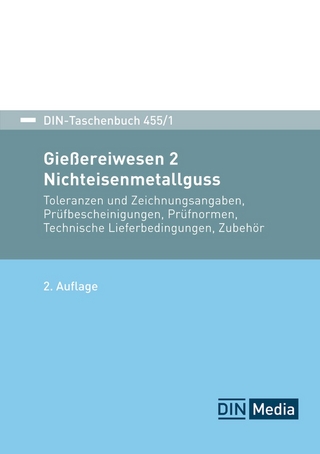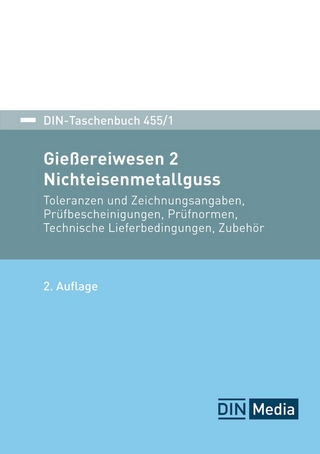
Design Analysis in Rock Mechanics
Taylor & Francis Ltd (Verlag)
978-0-415-40357-3 (ISBN)
- Titel ist leider vergriffen;
keine Neuauflage - Artikel merken
In a straightforward manner and with plenty of illustrations, this textbook approaches important design issues in rock mechanics from a mechanics of materials foundation. It addresses rock slope stability in surface excavations, shaft and tunnel stability, and entries and pillars. The book also covers three-dimensional caverns with an emphasis of backfill and cable bolting and addresses the geometry and forces of chimney caving. Appendices contain supplementary information about rock, joint, and composite properties, rock mass classification schemes, and useful formulas. Designed as a course book, it contains numerous exercises and examples to familiarize the reader with practical problems in rock mechanics through various design analysis techniques and their applications. The appendices provide supplementary information about rock, joint, and composite properties, rock mass classification schemes, useful formulas, and an extensive literature list. A solutions manual, containing all worked solutions is also available (ISBN 9780415457255). Intended for rock mechanics courses to undergraduate and first year graduate students in mining and civil engineering; also suited as an introduction to rock mechanics for other engineers.
Professor Pariseau studied Mining Engineering at the University of Washington, Seattle and obtained his Ph.D. Degree from the University of Minnesota. He has many years of experience in teaching, research and in consulting for government agencies and mining companies. He received several prestigious awards and maintains an active presence in several professional societies and editorial boards. He currently occupies the Malcolm McKinnon endowed chair in the Department of Mining Engineering at the University of Utah.
PREFACE
ACKONWLEDGEMENTS
1. INTRODUCTION
1.1 A Practical Design Objective
1.2 Problem Solving
1.3 Units
1.4 Background Information
- Rock Mechanics Literature
- Mechanical Properties of Rock
1.5 Problems
2. SLOPE STABILITY
2.1 Translational Rock Slope Failures
- Planar Block Slides
- Safety Factor Improvement
- Wedge Failures
2.2 Rotational Slope Failures
- Remedial Measures
- Base Failures
- Toppling Failures
2.3 Problems
3. SHAFTS
3.1 Single Unlined Naturally Supported Shafts
- Shaft Wall Stress Concentration
- Unlined Circular Shafts
- Unlined Elliptical Shafts
- Unlined Rectangular Shafts
- Shaft Wall Strengths
3.2 Shaft Wall Support and Liners
- Shaft Wall Bolting
- Circular Shaft Liners
- Circular Steel Rings
3.3 Multiple Naturally Supported Shafts
- Circular Shafts in a Row
- Shaft Pillar Safety
- Two Circular Shafts of Different Diameter
- Elliptical Shafts in a Row
- Rectangular Shafts in a Row
3.4 Problems
4. TUNNELS
4.1 Naturally Supported Tunnels
- Single Tunnels
- Multiple Tunnels
4.2 Tunnel Support
- Fixed Steel Sets
- Pattern Bolting - Reinforcement
- Combination Support
- Yieldable Steel Arches.
- Light Segment Liner
4.3 Problems
5. ENTRIES IN STRATIFIED GROUND
5.1 Review of Beam Analysis
- Basic Beam Formulas
- Important Special Cases
5.2 Soft Rock Entries
- Naturally Supported Entries
- Point Anchored Roof Bolts
- Distributed Anchorage Roof Bolts
- Roof Trusses
5.3 Problems
6. PILLARS IN STRATIFIED GROUND
6.1 Pillars in a Single Seam
- Tributary Area, Extraction Ratio Analysis
- Size Effect on Strength
6.2 Pillars in Dipping Strata
- An Unconventional Mohr’s Circle Representation
- Generalized Mohr’s Circle
- Backfill Effect on Pillar Safety Factors
6.3 Pillars with Joints
- Flat Seam Pillars with Joints
- Dipping Seam Pillars with Joints
6. 4 Pillars in Several Seams
- Columnized Main Entry Pillars
- Staggered Chain Entry Pillars
6. 5 Barrier Pillars
6.6 Problems
7. THREE-DIMENSIONAL EXCAVATIONS
7.1 Naturally Supported Caverns and Stopes
- Spheroidal Excavations
- Cubical and Brick-shaped Excavations
- Tabular Excavations
7.2 Joints in Cavern and Stope Walls
7.3 Tabular Excavations
7.4 Cavern and Stope Support
- Hardrock Mine Fill
- Cable Bolt Support
7.5 Problems
8. SUBSIDENCE
8.1 Chimneys
- Chimney Cave Geometry
- Caving Rock Flow
- Chimney Cave Forces
- Chimney Cave Water Forces
- Support Near Caving Ground
8.2 Troughs
- Limits of Subsidence
- Maximum Subsidence
- Critical Width
- NCB Subsidence Profile
- NCB Strain Profile
- Surface Damage
- Multi-Panel, Multi-Seam Subsidence
- Alternative Approaches
8.3 Problems
REFERENCES
APPENDICES:
A - BACKGROUND LITERATURE
B - MECHANICAL PROPERTIES of INTACT ROCK and JOINTS
C - ROCK MASS CLASSIFICATION SCHEMES for ENGINEERING
D - SOME USEFUL FORMULAS
INDEX
| Erscheint lt. Verlag | 26.10.2006 |
|---|---|
| Zusatzinfo | 163 Line drawings, black and white; 163 Illustrations, black and white |
| Verlagsort | London |
| Sprache | englisch |
| Maße | 174 x 246 mm |
| Gewicht | 1171 g |
| Themenwelt | Technik ► Bergbau |
| ISBN-10 | 0-415-40357-X / 041540357X |
| ISBN-13 | 978-0-415-40357-3 / 9780415403573 |
| Zustand | Neuware |
| Informationen gemäß Produktsicherheitsverordnung (GPSR) | |
| Haben Sie eine Frage zum Produkt? |
aus dem Bereich


